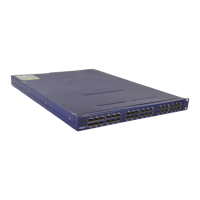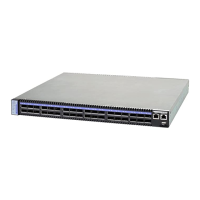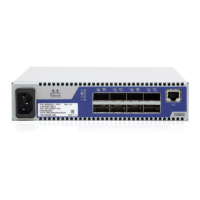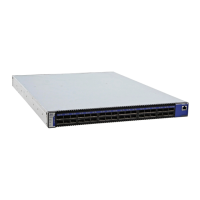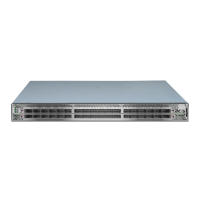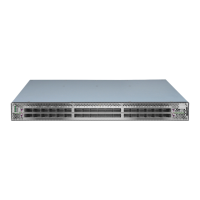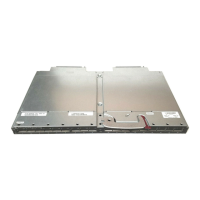
Do you have a question about the Mellanox Technologies Mellanox SX1018 and is the answer not in the manual?
| Manufacturer | Mellanox Technologies |
|---|---|
| Model | SX1018 |
| Category | Switch |
| Ports | 18 |
| Form Factor | 1U |
| Ports Type | QSFP+ |
| Switch Type | Top of Rack |
| Data Transfer Rate | 10 Gbps |
| Switching Capacity | 1.44 Tb/s |
| Throughput | 133.92 Mpps |
| Power Supply | AC |
Identifies the target audience for this manual, typically network administrators.
Lists other Mellanox documents referenced within this user manual.
Details the general and Ethernet-specific features supported by the MLNX-OS.
Step-by-step instructions to perform the initial configuration of the switch.
Instructions on how to restart the initial configuration wizard on the switch.
Explains how to connect to and start using the switch's Command Line Interface.
Provides steps to access and log into the switch's Web User Interface (WebUI).
Lists the available license options (OPN) and their corresponding product validity and descriptions.
Step-by-step guide for installing an MLNX-OS license using the Command Line Interface.
Instructions for installing an MLNX-OS license through the switch's Web User Interface.
Procedure to follow if a license key is lost, requiring the chassis serial number.
Detailed explanation of the industry-standard Command Line Interface for switch management.
Describes the different modes within the CLI (Standard, Enable, Config) and their capabilities.
Explains the conventions used for presenting command syntax in the manual.
How to access context-sensitive help within the CLI using the question mark symbol.
Details the format of CLI prompts and how the system responds to commands.
Explains how to use the 'no' keyword to disable functions or reset parameters in the CLI.
Provides a key to understand the meaning and format of angle-bracketed parameters in commands.
Describes the MLNX-OS Web GUI, supported browsers, and available perspective tabs.
Details the submenus available under the Setup tab in the Web UI for system configuration.
Outlines the submenus within the System tab for viewing system modules and information.
Lists the submenus for managing user accounts, passwords, SSH, AAA, RADIUS, LDAP, and certificates.
Describes the Ports menu for viewing port state and configuring port attributes.
Details the submenus for viewing system status, temperature, power supplies, CPU load, and logs.
Management options for InfiniBand Subnet Manager, noting it's not for Ethernet systems.
Information on the Fabric Inspector tool, its applicability, and requirements.
Management options for Ethernet-specific features like Spanning Tree, MAC Table, VLANs, and ACLs.
How to configure the network interface for managing the switch, including IP settings.
Steps to switch from DHCP to static IP assignment for management interfaces.
Procedures for enabling and configuring IPv6 addresses on the management interface.
Explains the role of DHCP in automatically retrieving management IP addresses.
Instructions on how to manually configure the default gateway for the system.
How to set up management channels through data ports using VLANs.
Detailed, multi-step process for upgrading the MLNX-OS software to a newer version.
Steps to remove old or unused MLNX-OS software images from the system.
How to revert to a previous version of the MLNX-OS software.
Process for switching to a partition containing an older software version, including configuration handling.
Information on how MLNX-OS attempts to update system firmware automatically after an OS update.
Steps to import a firmware package and set it as the new default for automatic updates.
How to save the current system configuration to the active or a specified file.
Procedures for loading a different configuration file and making it the active one.
Information on binary configuration files, which are not human-readable.
Details on editable text-based configuration files and their application.
How to print logging events and system notifications directly to the terminal.
Configuration steps to send syslog messages to a remote syslog server.
Describes how MLNX-OS supports event notifications via email, SNMP, or terminal.
Specific commands and formats for accessing USB devices attached to the switch.
How to configure the CLI to halt on command failure and pass exit codes.
Explains the AAA framework for controlling access, enforcing policies, and tracking usage.
Information on using RADIUS for centralized user authentication and authorization.
Details on TACACS+ protocol for centralized user authentication and accounting services.
Explanation of LDAP for authenticating users against a centralized directory.
Configuration and usage of SSH for secure remote access to the switch.
Describes the available user account types (admin, monitor) and their default credentials.
Configuration and support for Simple Network Management Protocol (SNMP) on the switch.
Lists standard Management Information Bases (MIBs) and their associated RFCs.
Information on Mellanox-specific private MIBs for enhanced management.
Details the SNMP traps supported by MLNX-OS, specific to Mellanox hardware.
Steps to activate the SNMP server and configure its basic settings on the switch.
Guide for setting up SNMPv3 users with authentication and privacy protocols.
How to configure the switch to send SNMP notifications (traps or informs) for specific events.
Information about using the MLNX-OS XML API for programmatic management and information retrieval.
Describes the configurable parameters for Ethernet interfaces on the switch.
Explains the use of Mellanox's unique capability to split 40Gbps ports into multiple 10Gbps ports.
Details which ports can be split, the implications of splitting, and the resulting port configurations.
Procedure to change an interface's module type to enable port splitting functionality.
Steps to revert a split port back to its original QSFP configuration.
Step-by-step guide to configure a static Link Aggregation Group on the switch.
How to enable and configure LACP for dynamic negotiation of LAGs between devices.
Explanation of Virtual Local Area Networks (VLANs), their identification, and port modes.
Steps to configure an access port and assign a default VLAN ID (PVID).
Guide for configuring hybrid ports and assigning a PVID for tagged and untagged frame handling.
How to configure trunk ports for inter-switch connections, allowing tagged frames for specific VLANs.
Steps to configure hybrid ports for VLAN membership, allowing tagged and untagged frames.
How to manually configure static MAC addresses for specific unicast traffic flows.
How STP port priority and cost influence forwarding and blocking states in a loop.
Configuration options for port types (edge, normal, network) and their impact on STP convergence.
How to use BPDU filter to prevent sending or receiving Bridge Protocol Data Units on specific ports.
Feature to prevent network loops by detecting and blocking ports that stop receiving BPDUs.
Prevents a port from becoming a root port by blocking it if STP convergence is triggered by a root BPDU.
Steps to globally enable IGMP snooping and enable it on specific VLANs.
How to define a port as a multicast router port on a VLAN using trunk or hybrid modes.
Instructions for configuring the Link Layer Discovery Protocol (LLDP) on the switch for network device advertising.
Explains Priority Flow Control (PFC) for creating no-drop traffic classes on Ethernet links.
Steps to enable Priority Flow Control (PFC) globally across the entire switch.
How to enable PFC for specific traffic priorities on the switch.
Steps to enable PFC on a specific Ethernet interface, including setting the mode.
Configuration of Enhanced Transmission Selection (ETS) for bandwidth allocation and traffic class scheduling.
Step-by-step process for creating and applying ACL rules to switch interfaces.
Defines actions to be taken when an ACL rule is matched, such as modifying VLAN tags.
How to configure mirroring sessions, associating source ports with analyzer ports.
Specifies the analyzer port to which mirrored traffic is sent, supporting multiple destinations.
Options for manipulating mirrored traffic headers, including adding VLAN tags or Ethernet headers.
Manages congestion on the analyzer port by using flow control or dropping excessive frames.
Option to truncate mirrored packets to a fixed size (e.g., 64 bytes) for analysis.
Practical steps to set up a port mirroring session, including source, destination, and format.
How to check the configuration and status of active port mirroring sessions.
Details on flow sampling parameters like truncation and sampling rate for traffic analysis.
Information on interface counters sampled over time and the statistics gathered.
Describes the structure and content of sFlow datagrams sent to the collector.
Requirements for enabling sFlow on physical or LAG interfaces.
Step-by-step guide to set up the sFlow agent, collector, and agent IP addresses.
How to check the configuration and operational status of the sFlow agent.
